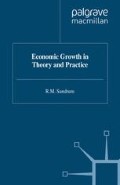Abstract
As discussed in the last chapter, prevailing theories have sought to explain growth by taking the economy as a whole, though the assumptions about the economy have been derived from the characteristics of particular sectors. Thus, the classical theory was based on the agricultural economy, and the neo-classical theory on the industrial economy. The Lewis model distinguishes two sectors, but the main concern is with the growth of the modern or industrial sector, with the traditional sector only playing the role of supplying labour to the modern sector at a constant wage rate. It is only in the Butt model that all sectors of the economy are considered, and the growth process explained in terms of the sequence in which different sectors are mechanised by the introduction of fixed capital.
Access this chapter
Tax calculation will be finalised at checkout
Purchases are for personal use only
Preview
Unable to display preview. Download preview PDF.
Copyright information
© 1990 R. M. Sundrum
About this chapter
Cite this chapter
Sundrum, R.M. (1990). Growth in The Agricultural Sector. In: Economic Growth in Theory and Practice. Palgrave Macmillan, London. https://doi.org/10.1057/9780230376816_5
Download citation
DOI: https://doi.org/10.1057/9780230376816_5
Publisher Name: Palgrave Macmillan, London
Print ISBN: 978-1-349-38947-6
Online ISBN: 978-0-230-37681-6
eBook Packages: Palgrave Economics & Finance CollectionEconomics and Finance (R0)

